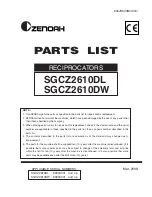
14
between the saw blade and support wheel (with a drop
of oil) and the support axle of the wheel itself.
9. ADJUSTING THE PENDULAR MOVEMENT
The pendulum mechanism provides blade swivel mo-
tion with improved cutting and higher work speed
per material.
To adjust with of swivel, use control 13 (Fig. 9). At 0
there is no swivel.
Pendular movement is increased from position 1 to
position 3. Change of setting can be carried out with
the machine in motion.
Read the optimum operating conditions according to
the specific material being worked.
MATERIAL
WHEEL POSITION
WOOD
1-2-3
STEEL
0
ALUMINIUM 0-1
RUBBER
0
CERAMICS
0
10. ELECTRONIC SPEED ADJUSTMENT
The machine has an electronic circuit that permits a
smooth start and maintains a practically constant speed
up to its rated power. You will find the adjustment wheel
16 (Fig. 0) at the left side of the tool.
Adjustment control 16 (Fig. 0) is used to set the required
speed. Number 1 corresponds to the minimum speed and
number 6 is the maximum obtainable speed by means
of the electronic circuit.
Electronic regulation can be carried out with the machine
running. The optimum number of strokes, depends on
the material and particularly on the working conditions
which can be achieved with practice.
11. TYPES OF CUTS
Always be sure that the tool is switched
off and the battery cartridge is removed
before adjusting or checking function
on the tool.
Bevel cutting (Fig. 7)
To work with inclined cuts, loosen screw 23 (Fig. 7) with
service key 17 (Fig. 7), and incline the base according
to the desired cutting angle, which is indicated on
graduated scale 24 (Fig. 8) on the base itself. Firmly
tighten screw 23 (Fig. 7).
The base should be placed as far forward as possible to
allow for unlimited saw blade inclination.
Vertical cuts
The base is placed as far back as possible so that the
blade is centered at.
To start working on wood on inner cuts (Fig. 6) the
assembly car be beared through the front portion of
the base plate and slowly press until the saw blade has
gone through the material to be processed.
If there is no training or when working on other mate
-
rials it is necessary to make a previous adjustment hole.
To carry out this the pendulum mechanism should 13
(Fig. 9) be at position 0.
12. PLASTIC OVERLAY FOR DELICATE SURFACES
Always be sure that the tool is switched
off and the battery cartridge is removed
before adjusting or checking function
on the tool.
To install the plastic overlay, clip it onto the front of
support base 14 (Fig. 1 and 2) as shown in (Fig. 2). Press
the rear section upwards until it is locked in place as
shown in (Fig. 2).
Support base 14 (Fig. 2) which is fitted with a steel insert
provides a high degree of stability and may be used
without plastic overlay 15 (Fig. 2) to work on metal or
other non-delicate surfaces.
It is recommended that plastic overlay 15 (Fig. 2) is
used with material that is easily scratched in order not
to damage delicate surfaces.
13. WORKING INSTRUCTIONS
It is possible to cut wood without having made a previous
drill hole, allowing the blade to slowly penetrate into the
material with the machine in operation. However, this
does require a certain amount of experience.
Support the front edge of base plate 14 (Fig. 6) incli
-
ning the machine upwards and switch it on. Support
the machine
firmly against the work-piece and slowly lower it so that
the saw blade penetrates the work-piece.
Once the material has been cut through, place the
machine into its normal operating position so that the
base plate is seated on its entire surface area and con-
tinue the sawing operation according to requirements.
When sawing is completed, first switch the machine off
and then remove the blade from the saw slot.
14. OPTIONAL JIG SAW BLADES
(5 pcs blisters)
• 3440095 Fine cut, for soft and hard wood up to 60 mm.
(HCS, pitch 4 mm, length 75 mm)
• 3440167 Fine cut, for soft and hard wood up to 80
mm. (HCS, pitch 4 mm, length 105 mm)
• 3440094 Curved cut, for soft and hard wood up to 60
mm. (HCS, pitch 4 mm, lenght 75 mm)















































